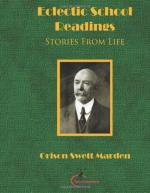“Bernard of the tuileries”
Opposite the entrance to the Sevres Museum in the old town of Sevres, in France, stands a handsome bronze statue of Bernard Palissy, the potter. Within the museum are some exquisite pieces of pottery known as “Palissy ware.” They are specimens of the art of Palissy, who spent the best years of his life toiling to discover the mode of making white enamel.
The story of his trials and sufferings in seeking to learn the secret, and of his final triumph over all difficulties, is an inspiring one.
Born in the south of France, as far back as the year 1509, Bernard Palissy did not differ much from an intelligent, high-spirited American boy of the twentieth century. His parents were poor, and he had few of the advantages within the reach of the humblest child in the United States to-day. In spite of poverty, he as cheerful, light hearted, and happy in his great love for nature, which distinguished him all through life. The forest was his playground, his companions the birds, insects, and other living things that made their home there.
From the first, Nature was his chief teacher. It was from her, and her alone, he learned the lessons that in after years made him famous both as a potter and a scientist. The habit of observation seemed natural to him, for without suggestions from books or older heads, his eyes and ears noticed all that the nature student of our day is drilled into observing.
The free, outdoor life of the forest helped to give the boy the strength of mind and body which afterward enabled him, in spite of the most discouraging conditions, to pursue his ideal. He was taught how to read and write, and from his father learned how to paint on glass. From him he also learned the names and some of the properties of the minerals employed in painting glass. All the knowledge that in after years made him an artist, a scientist, and a writer, was the result of his unaided study of nature. To books he was indebted for only the smallest part of what he knew.




